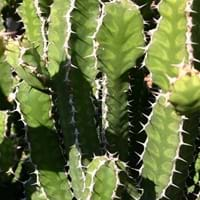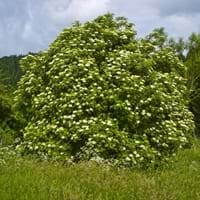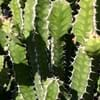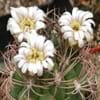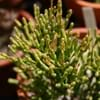Life Span
Perennial
Perennial
Type
Cactus, Shrub
Flowering Plants, Fruits, Herbs, Shrubs
Origin
Southern Africa, South Africa
Australia, South America
Types
Not Available
Adams Elderberry, Black Beauty Elderberry, Black Lace Elderberry, Johns Elderberry, Nova Elderberry
Number of Varieties
Not Available
Habitat
Bushlands, Upland savannas
Farms, Homesteads, Near organic waste disposal
USDA Hardiness Zone
10-15
4-8
Sunset Zone
H1, H2, 13, 21, 22, 23, 24
2a, 2b, 3a, 3b, 4, 5, 6, 7, 14, 15, 16, 17
Habit
Upright/Erect
Upright/Erect
Flower Color
Light Yellow, Yellow green, Gold
White
Flower Color Modifier
Not Available
Not Available
Fruit Color
Not Available
Purple, Red
Leaf Color in Spring
Not Available
Green
Leaf Color in Summer
Not Available
Green
Leaf Color in Fall
Not Available
Yellow green
Leaf Color in Winter
Not Available
Not Available
Leaf Shape
Succulent
Compound
Plant Season
Spring, Summer, Fall, Winter
Early Spring
Sunlight
Full Sun, Partial Sun, Partial shade
Full Sun, Part sun
Growth Rate
Medium
Medium
Type of Soil
Loam, Sand
Loamy, Sandy, Well drained
The pH of Soil
Acidic, Neutral, Alkaline
Slightly Acidic
Soil Drainage
Well drained
Average
Bloom Time
Spring, Late Spring
Early Spring, Spring
Tolerances
Drought
Pollution
Where to Plant?
Container, Ground, Pot
Ground
How to Plant?
Cuttings
Grafting, Seedlings
Plant Maintenance
Medium
Medium
Watering Requirements
Needs very little water, occasional watering once established
Requires regular watering, Use Mulches to help prevent water loss during hot and windy weather
In Summer
Lots of watering
Lots of watering
In Spring
Moderate
Moderate
In Winter
Average Water
Average Water
Soil pH
Acidic, Neutral, Alkaline
Slightly Acidic
Soil Type
Loam, Sand
Loamy, Sandy, Well drained
Soil Drainage Capacity
Well drained
Average
Sun Exposure
Full Sun, Partial Sun, Partial shade
Full Sun, Part sun
Pruning
Remove damaged leaves, Remove dead branches, Remove dead leaves
Cut or pinch the stems, No pruning needed in the early stages, Prune for shortening long shoots, Prune if you want to improve plant shape, Prune in winter, Prune ocassionally, Remove deadheads
Fertilizers
All-Purpose Liquid Fertilizer
All-Purpose Liquid Fertilizer
Pests and Diseases
Mealy bugs, Soft scales
Canker, Leaf spot, Powdery mildew, Stem spot, Tomato Ringspot Virus
Plant Tolerance
Drought
Drought
Flowers
Insignificant
Yes
Flower Petal Number
Single
Single
Foliage Texture
Bold
Medium
Foliage Sheen
Not Available
Matte
Attracts
pollinators
Birds
Allergy
Nausea, Skin irritation, Vomiting
Diarrhea, Nausea, Vomiting
Aesthetic Uses
Ground Cover
Not Used For Aesthetic Purpose
Beauty Benefits
Not Available
Not Available
Environmental Uses
Air purification
Air purification
Medicinal Uses
Asthma, Bronchitis, Diarrhea
constipation, Fever, Heart problems, High cholestrol, HIV/AIDS, Nerve pain, swine flu
Part of Plant Used
Sap
Flowers, Fruits
Other Uses
Container, useful as a ground cover
Not Available
Used As Indoor Plant
Yes
No
Used As Outdoor Plant
Yes
Yes
Garden Design
Container, Feature Plant, Houseplant, Rock Garden, Wall
Not Available
Botanical Name
Euphorbia pseudocactus
Sambucus nigra
Common Name
Tiger Tree
Elderberry
In Hindi
टाइगर ट्री
Elderberry
In German
Tiger Tree
Holunderbeere
In French
Tiger Tree
Sureau
In Spanish
Tiger Tree
Saúco
In Greek
Tiger Tree
Elderberry
In Portuguese
Tiger Tree
Sabugueiro
In Polish
Tiger Tree
Bez czarny
In Latin
tigris lignum
Elderberry
Phylum
Magnoliophyta
Magnoliophyta
Class
Magnoliopsida
Magnoliopsida
Order
Malpighiales
Dipsacales
Family
Euphorbiaceae
Adoxaceae
Clade
Angiosperms, Eudicots, Rosids
Angiosperms, Asterids, Eudicots
Tribe
Euphorbieae
Not Available
Subfamily
Euphorbioideae
Not Available
Season and Care of Tiger Tree and Elderberry
Season and care of Tiger Tree and Elderberry is important to know. While considering everything about Tiger Tree and Elderberry Care, growing season is an essential factor. Tiger Tree season is Spring, Summer, Fall and Winter and Elderberry season is Spring, Summer, Fall and Winter. The type of soil for Tiger Tree is Loam, Sand and for Elderberry is Loamy, Sandy, Well drained while the PH of soil for Tiger Tree is Acidic, Neutral, Alkaline and for Elderberry is Slightly Acidic.
Tiger Tree and Elderberry Physical Information
Tiger Tree and Elderberry physical information is very important for comparison. Tiger Tree height is 30.00 cm and width 30.00 cm whereas Elderberry height is 9.00 cm and width 8.00 cm. The color specification of Tiger Tree and Elderberry are as follows:
Tiger Tree flower color: Light Yellow, Yellow green and Gold
Tiger Tree leaf color: Not Available
Elderberry flower color: White
- Elderberry leaf color: Green
Care of Tiger Tree and Elderberry
Care of Tiger Tree and Elderberry include pruning, fertilizers, watering etc. Tiger Tree pruning is done Remove damaged leaves, Remove dead branches and Remove dead leaves and Elderberry pruning is done Cut or pinch the stems, No pruning needed in the early stages, Prune for shortening long shoots, Prune if you want to improve plant shape, Prune in winter, Prune ocassionally and Remove deadheads. In summer Tiger Tree needs Lots of watering and in winter, it needs Average Water. Whereas, in summer Elderberry needs Lots of watering and in winter, it needs Average Water.
